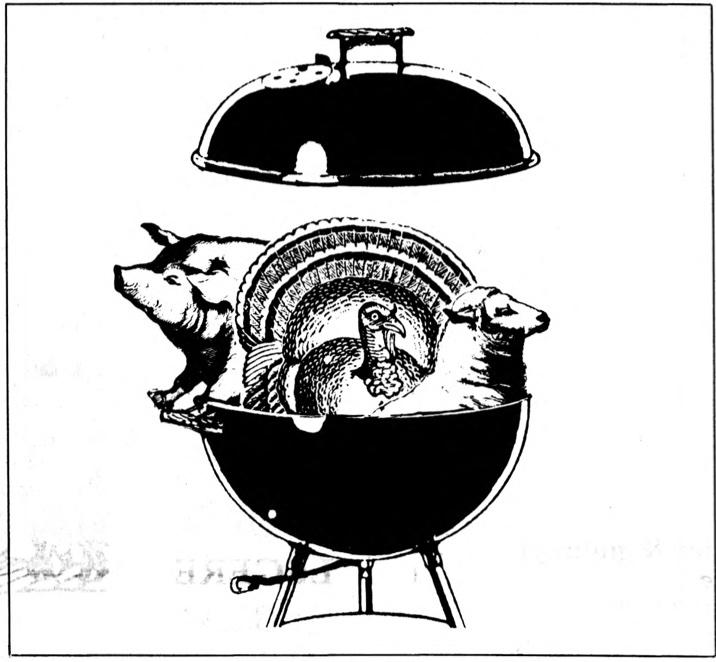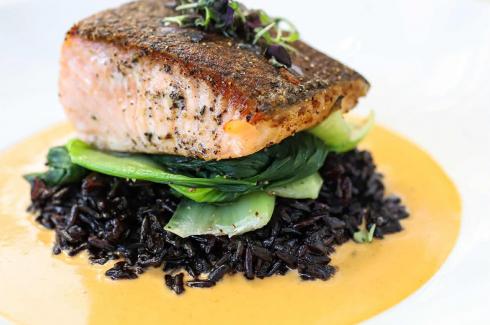“Grilling was brought to perfection by the English and transformed to an art by the French.” — James Beard, “Outdoor Cooking”
Them’s fightin’words in Texas and all over the South, where everybody thinks that they, personally, are the only people that know how to barbecue correctly. Mr. Beard, who hailed from Seattle, attributed his love of outdoor cookery to his indomitable mother who could, he vows, make a bonfire on the beach out of wet drift wood! Most of us rely on charcoal briquets and curses or a gas-fired grill for our outdoor cooking adventures.
Outdoor fire-and-smoke cookery has come a long way since Mr. Beard published his book on the subject in 1960 — even to devices for indoor barbecuing in winter — and more sophisticated grills have evolved. I’m still very fond of the double hibachi, which doesn’t require mountains of charcoal, but I also have a Weber kettledrum grill on wheels, which seems to be the most versatile and the hands-down favorite of many people who do a lot of outdoor cooking.
However, the gas grill, with its reliable source of high, steady, heat, is gaining popularity. (Two of my friends, both adroit char-cooks, have acquired rather elaborate gas grills but have never deaccessioned their battered old charcoal grills — just in case.) By using lava rocks in this type of grill, you can throw in dampened wood chips in many different flavors (mesquite, applewood, cherry, hickory, and grapevine cuttings are a few) to get an authentic smoky taste.
Quick-Start Works
Most of the grief has been removed from starting a charcoal fire by the invention of the “Chifriney Quick.” This is a tall metal canister with a wooden handle which you set over a piece of crumpled newspaper and fill with briquets. When the first piece of paper has burnt up, you add one more under the canister and in about five to 10 minutes you will have a bed of coals on which you can add a second layer if needed. Always set this device on the firebed of any grill. It gets extremely hot and it’s not a good idea to be carrying it any distance.
Because there are so many variables — the number of briquets and heat of the fire, the distance the food is from the coals, the size and thick ness of the meat, fish, or vegetables being grilled, the outside air temperature — it is a tricky business to give exact instructions for outdoor cookery.
Experience is really the only reliable teacher, but I have prized from Billy Powers, a maestro of the Weber whose charcoal-grilled food, from turkeys to lamb chops, is always perfect, a few recipes to share with you. His wife, Patsy, is sometimes allowed to prepare some marinades though not to approach the actual grill.
Billy’s Grilled Pork Loin
This amazingly tender and juicy pork roast is the result of cooking at high temperature a relatively short time in a covered Weber grill. To intensify the smoky flavor you can throw a small handful of soaked hickory chips on the coals at the begin ning of the cooking period.
Serves six to eight.
1 center cut pork loin roast (4-5 lbs.)
Salt and coarse pepper
2 Tbsp. chopped fresh rosemary
This, and all large, dense, pieces of meat, should be cooked using the “indirect method.” This consists of arranging the hot coals in racks on either side of the grill and placing a heavy foil drip pan and placing a heavy foil drip pan on the fire floor under the roast.
Have the butcher bone the loin and tie it back on its rack of bones. Rub it with the salt, pepper, and rosemary, wrap it loosely, and let it rest at room temperature an hour or so. It is vital to the cooking time that the meat isn’t refrigerator-cold.
When the coals are pink and covered with white ash, lay the roast on top of the oiled grill rack directly over the drip pan and put on the cover, with its vents fully open. The lower vents un der the coals should also be fully open. Roast — do not baste or peek —for about one and a half hours to an internal temperature of 150 degrees.
Let the pork rest on a board for about 10 minutes before carving so that it will retain all its juices.
Grilled Whole Leg Of Lamb
Butterflied leg of lamb has been seen on fashionable grills for over 20 years but whole leg of lamb is far less commonplace. It too, must be roasted using the “indirect method” as outlined above, to an interior temperature of 130 degrees.
1 whole leg of lamb (about 8 lbs.)
Marinade: (optional)
3/4 cup olive oil
1/4 cup lemon juice
1 Tbsp. tarragon vinegar
1 Tbsp. minced garlic
1 cup diced onion
2 bay leaves
1/2 tsp. each: thyme, oregano, pepper
Trim the lamb of as much fat as possible. Mix together the marinade ingredients and rub it all over the lamb, turning it occasionally for three or four hours.
Make a good fire with about 36 coals and shovel them into the two side racks of a Weber grill. Place the drip pan and put on the cover, with its one hour and 20 minutes until an instant-read thermometer reads 130 degrees. Keep the top and bottom vents open during the entire roasting time. Let the lamb rest for at least 15 minutes before carving into fairly thin slices more or less vertically.
Note: If you haven’t time for the marinating process at least be sure to take the meat out of the refrigerator for an hour before cooking and rub it well with olive oil, pulverized garlic, salt, and pepper.
The Map To Better Barbecuing
• Read the instruction booklet that came with your barbecue grill; the recipes are usually awful and the cooking times too long, but you need to know the capabilities of your equipment.
• Start all large or thick pieces of meat or poultry at room temperature unless you are seeking a blackened or very dark exterior and a rare interior, as in “black-and-blue” steak.
• Trim all meats of excess fat to avoid fat flare-ups when cooking di rectly over the coals.
• Keep moving small items such as hamburgers, vegetables, or sausages from one part of the grill to another for even cooking. Most grills have hot spots and cooler spots — a grill basket that adjusts in thickness is handy for turning over small items like shrimp all at one time.
• Have a spray container of water at the ready to calm flare-ups that produce a greasy, burnt flavor.
• Use tongs and wear a fireproof long glove for turning food.
• Never pierce meat or poultry with a fork. It creates a handy hole for all the flavor and juices to run out of.
• Split chickens and game hens down the back and flatten them with the flat side of a heavy cleaver for even cooking.
• Brush on any sauces only within the last five minutes of grilling.
• Always scrub the grill with a wire brush, dry it, and oil it to ready it for the next use.




